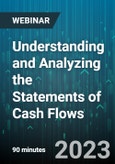Many people do not know how to use this valuable financial statement or are even aware of its existence. In 1995 the American Institute of CPAs started requiring this financial statement (FASB 95) for financial reporting transparency and to deal with the problem of high net income accompanied by negative cash flow. This statement highlights the important difference between earnings and cash flow.
In some instances, negative cash flow can be a good thing. For example, when a business is expanding, it might have a negative cash flow for investment in new property, plant, and equipment. A firm might also show negative cash flow because it is liquidating debt. But sometimes negative cash flow can be bad, especially if it results from regular business operations.
In addition to understanding the three major components of the Statement of Cash Flows it’s important to be able to use the newly created cash flow ratios. These ratios tell us the quality of reported net income, how a firm finances its expansion if cash generated from operations is sufficient and many other critical items related to cash flow.
Why you should Attend
This 90-minute webinar is ideal for CFOs, Controllers, Treasurers, budgeting, finance, and accounting staff, CPAs, VPs, Directors, and Managers of Finance, CEOs, General Managers, Bankers, Business Owners, and anyone who needs a better understanding of how a business gets its cash and uses its cash. At the conclusion of this valuable webinar, you will understand the difference between earnings and cash flow.Both experienced financial professionals and non-financial professionals will benefit from this knowledge. This webinar is designed: (1) as a follow-up for people who have attended How to Understand and Analyze Financial Statements for Non-Financial Professionals and (2) for experienced financial professionals who need an organized method of understanding and analyzing the Statement of Cash Flows.
Areas Covered in the Session
- How to use the third required financial statement - The Statement of Cash Flows
- The three basic sections of the Statement of Cash Flows - The sections, the information contained, and what to look for
- How to Evaluate Cash Flow from Operations to Determine the Quality of Earnings
- Tricks That Make Tepid Earnings Look Great
- Why Slow Sales and Slow Collections Have a Major Impact on Cash
- How to Analyze Year-To-Year Cash Flow by Category
- How to Construct a Horizontal Analysis Cash Flow Template
- How to Analyze the Sources and Uses of Cash by Three Major Categories
- How to Construct a Vertical Analysis Cash Flow Template
- How to Use the Excel = IF Statement for Analysis
- Nine Cash Flow Metrics, What They Measure and What They Mean
- How to Link Excel Formulas from Different Worksheets
Agenda:
- Brief Review of Balance Sheet and Income Statement Financial Analysis
- Troubleshooting with Horizontal and Vertical Analysis
- Financial Ratio Analysis
- Understanding the Basic components of the Statement of Cash Flows - Cash Flows Components:
- Operations (CFO)
- How the Business Operating Cycle Impacts Cash Flow
- Adjustments for Non-Cash Items on the Income Statement
- Investing (CFI)
- Financing (CFF)
- Analyzing cash flow from/for:
- Operations (CFO)
- Investing (CFI)
- Financing (CFF)
- Year-to-year by percent in/out for a rapid analysis
- Calculate, understand and use the new cash flow ratios
- Liquidity - CFO/Average Current Liabilities
- Efficiency and Income
- CFO/Revenue
- CFO/Net Income
- CFO/Cash Outflow for Investments
- CFI Outflow/Total Outflow
- Cash in Fin./Cash in Operations
- Solvency
- CFO/Average Total Liabilities
- (CFO + Int. Paid)/Int. Paid
- Profit
- CFO per Share
- Stock Price
- Cash Flow Multiple
- FASB 95 on a Spreadsheet - Constructing an Excel Template
Speaker
Joseph Weil has a Master of Accounting Degree from Florida State University and is an actively licensed Florida CPA. Joe’s work experience includes staff accountant with large CPA firm, corporate controller, state agency director of auditing and former municipal CFO. Joe also started and sold his own CPA firm. Joe is the owner and CEO of the National Center for Continuing Education, a nation-wide financial and technology training firm. Joe has led over 500 seminars and over 100 webinars.Who Should Attend
- CFOs
- Controllers
- Treasurers
- Budgeting
- Finance and Accounting Staff
- CPAs
- VPs
- Directors and Managers of Finance
- CEOs
- General Managers
- Bankers
- Business Owners








